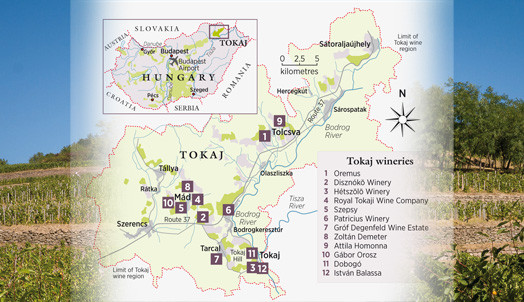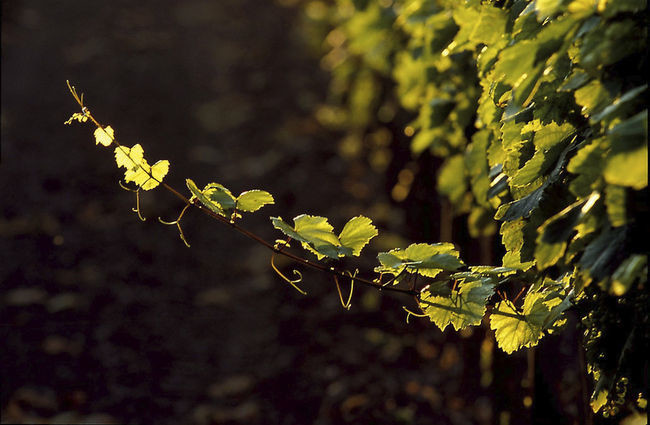Tokaj: bespoke wine tours
Spring, summer and especially autumn – when the botrytised grapes hang from the vines – are beautiful seasons for visiting.

Bespoke wine tours
Situated 240km from Budapest, the region of Tokaj comprises 27 villages and towns stretching nearly 50km between Tokaj, the southernmost town, to Sátoraljaújhely in the north (visit tokaji-borut.hu for useful information).
Spring, summer and especially autumn – when the botrytised grapes hang from the vines – are beautiful seasons for visiting. The white Furmint, Hárslevelu and Sárga Muskotály (Muscat Lunel) varieties are the most common, but there are also smatterings of old varieties Kövérszolo, Zéta and Kabar. All thrive in the region’s continental climate and loess and clay soils with rocky volcanic subsoils. But Furmint, with its Riesling-like acidity and ageing potential, covers 60% of Tokaj’s vineyards, while its alter-ego, the softer, aromatic Hársleveu, grows in 30%.
Visiting Tokaj’s wineries is a treat. Most do not hold scheduled tours, so appointments must be booked by phone or email. This means that your visits are one-on-one experiences, and will provide you with an authentic insight into the wines and each winery’s approach to making them. Some wineries have restaurants and shops, but most do not. Nevertheless, it is usually always possible to buy wines on site.
English is spoken at many of the wineries in Tokaj, but it could be advantageous to have an interpreter and tour guide. One of the best is Gergely ‘Greg’ Somogyi (www.tokajtoday.com/tokaj-travel-expertise), who provides incomparable service.
Puttonyos: key to sweetness
Entering the region on route 37, just past the town of Szerencs, you come to the Disznóko winery (disznoko.hu). This impressive, 104-hectare estate produces an array of wine styles: dry, szamorodni (made partly of botrytised grapes, and can be dry or sweet), late-harvest, eszencia (pure free-run juice from botrytised grapes) and, most notably, Tokaji aszú five puttonyos and six puttonyos.
The number of puttonyos – named for the puttony, a traditional Hungarian grape harvesting hod – indicates the natural sugar content of an aszú wine: five puttonyos has a minimum of 120g/l and six puttonyos has at least 150g/l. Disznóko’s elegant Aszú 5 Puttonyos 2007 and the bolder, superbly luscious Aszú 6 Puttonyos 2002 are two of its finest.
For decades, residual sugar levels of Tokaji aszú have ranged from three to six puttonyos. But as a result of the region’s recent upgrading of the wine style and its image, all aszú as of the 2013 vintage must be made with a minimum five puttonyos – making the light, softer styles more or less obsolete. Also as of 2013, aszú must be matured for at least 24 months before release, 18 of these in oak (vintages prior to 2013 required at least 36 months of maturing with 24 months in oak). Fresher, deeper wines and a premium status are the aims.
Just a few kilometres from Disznóko is the town of Mád (pronounced maahd), where the region’s most influential and respected producer, István Szepsy (info@szepsy.hu) makes his wines. Make an appointment to taste some of his beauties, such as his Aszú 6 Puttonyos 2006 with its honey, mandarin and golden raisin flavours, and the Edes Szamorodni 2009, wafting with elegant stone fruit, lavender and marzipan aromas. Szepsy’s knowledge of the Tokaj vineyards, and his approach to winemaking, are so captivating that speaking with him alone would make a trip to Tokaj worthwhile.
Other notable Mád producers include Royal Tokaji Wine Co, Uri Borok and Szent Tamás. If there’s no time to visit these wineries, no doubt many of the wines can be tasted at the newest restaurants and cafés in town, such as the upscale Gusteau and trendy Elso Mádi Borház.
Talented producers
In the region’s namesake town of Tokaj, a former protégé of Szepsy, Zoltán Demeter (demeterzoltan.hu), is a combination of renegade and traditionalist. He has recordings of Mozart playing day and night in his cellar to coddle his maturing wines, which include a sparkling Furmint and an elegant Furmint orange wine that sees a long maceration. Beyond compare is Demeter’s Aszú 6 Puttonyos 2008, which has astounding lushness and balance, a silky texture, and amazing apricot, orange, nectarine and sage notes.
Erzsébet Pince, Gizella, Sauska, Dobogó, István Balassa and Hétszolo are also excellent wineries in the town of Tokaj.
The sprawling 85ha Patricius estate (patricius.hu) in Bodrogkisfalud, 9km from both Mád and Tokaj, has fine, concentrated dry Tokajis that are just as beautiful as the restored centuries-old wine house in which they are made. The 2013 Furmint and Furmint Reserve are already showing stone fruit and saline-mineral expression. Just as exciting are the late-harvest and aszú wines.
In Tarcal, the Gróf Degenfeld wine estate (grofdegenfeld.com) has 35ha of organic vineyards and even its own forest for the barrels. Its range includes dry and sumptuous aszú, and the winery’s signature Andante 2008 which, despite its 220g/l residual sugar, cannot be labelled as aszú because of only one year’s barrel ageing (instead of the required two years at that time). Nevertheless, it is a juicy Furmint with vibrant acidity and smooth elegance – a characteristic of many Degenfeld wines.
If you have time, a drive up to the northern part of the region is worthwhile for sites such as the beautiful 16th-century Sárospatak Castle, which hosts the Great Tokaj Wine Auction every April. And in the village of Hercegkút nearby are impressive rows of vaulted wine cellars jutting out of the ground. The three-pronged Obzidián cellars (obzidianbor.hu) are impressive.
There are numerous other talented Tokaji producers to visit, or at least whose wines should be tasted while you’re in the region. These include Bordeaux-born Samuel Tinon (samueltinon.com) in Olaszliszka, who makes a supreme dry szamarodni, and János Arvay (www.arvay.eu), in Rátka, for his impressive pure Sárga Muskotály.
One way to conclude your visit to Tokaj is to head to the lookout point above Bodrogkerestúr. On an early autumn morning, with mists drifting across the wetlands, and with the Bodrog River and Mount Tokaj as backdrops, everything seems mystical – just like the Tokaji wines they inspire.
How to get there:
Fly to Budapest, then it’s a three-hour drive to Tarcal via the M3 motorway. A direct train from Budapest Keleti station to Tokaj takes 2.5 hours.
Translated by Sylvia Wu / 吴嘉溦
All rights reserved by Future plc. No part of this publication may be reproduced, distributed or transmitted in any form or by any means without the prior written permission of Decanter.
Only Official Media Partners (see About us) of DecanterChina.com may republish part of the content from the site without prior permission under strict Terms & Conditions. Contact china@decanter.com to learn about how to become an Official Media Partner of DecanterChina.com.


Comments
Submit